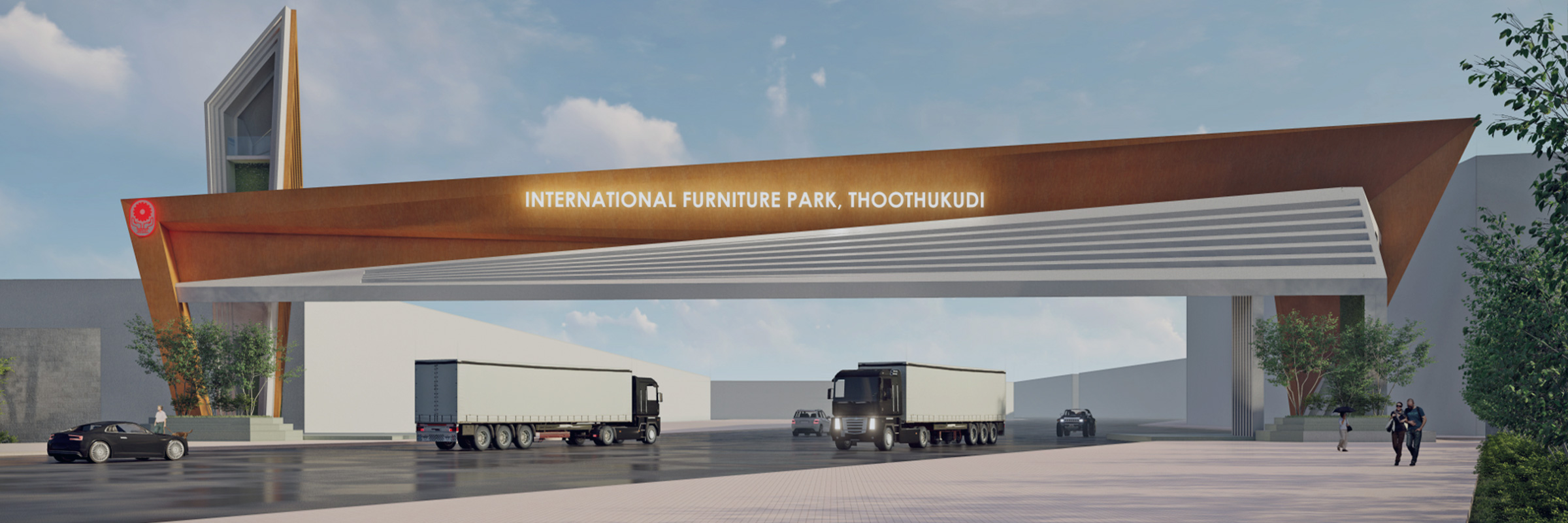

The masterplan for Thoothukudi International Furniture Park covers 465 hectares of evidence-based infrastructure planning. This thriving furniture park will be enabled by diligent phasing, interconnected transport infrastructure and development guidelines benchmarked against international best practice.
The Challenge
In 2021 the Government of India, Ministry of Commerce and Industry launched an ambitious plan to transform India into a Global Furniture Hub. In response the State Industries Promotion Corporation of Tamil Nadu (SIPCOT) is pioneering the first large-scale furniture park in the country. The park will incorporate furniture manufacturing, panel board manufacture, sawmill clusters, ancillary services, export infrastructure, skill development institute and residential villages.
The proposed masterplan needed to address several challenges such as assuring availability of certified cost-competitive raw materials, logistics, economy of scale and capacity building to future proof the industry. The Thoothukudi site was identified by the client due to its proximity to the port and an abundance of land, local labour, and raw materials. Therefore, the challenge for SMEC and Surbana Jurong was to:
- Overcome complexity with utility services and infrastructure overlay across an irregular shaped land parcel
- Study the furniture industry supply chain so that it could be translated into a functional masterplan
- Undertake rigorous infrastructure demand assessment to understand industry systems and processes
- Collate sufficient baseline information to inform the design and business case.
Thoothukudi, Tamil Nadu, India
Dec 2021 – Jan 2023
State Industries Promotion Corporation of Tamil Nadu Ltd (SIPCOT)
Surbana Jurong





The Solution
SMEC and Surbana Jurong undertook extensive outreach to initiate discussions with key players in the industry to understand their requirements, processes, and infrastructure dependencies. Pro-active consultation was conducted in tandem with in-depth bench marking studies. The master planning process broadly followed the following steps:
- Study of available data, land use and physical site details to establish baseline parameters to develop a techno-economic feasibility report.
- Detailed site analysis, field surveys, and investigations to prepare a base map.
- Consultation and research to inform the industry benchmarking report including infrastructure demand assessment.
- Preparation of concept plans, including infrastructure overlay, external linkages, and block cost estimates.
- Detailed master plan included land use, vehicle and pedestrian movement, open spaces, building massing & footprints as well as Floor Space Index.
- Detailed infrastructure and road network planning.
- Development of Urban Design guidelines and plot numbering plans.
- Development of design features and graphical illustration of key gateway nodes, junctions, and plazas.
Sustainable Infrastructure
As part of the masterplan process SMEC developed several innovative strategies to embed sustainability into the site infrastructure:
- Flexible pavements are designed to Million Standard Axles and California Bearing Ratio. The pavements are adaptable to changes in the underlying soil, traffic loads, and temperature variations. Benefits include cost savings, improved safety, and higher durability
- Overhead water tanks are strategically located at high ground to make use of gravity for distribution. The stormwater management concept incorporates a treated water reuse system informed by hydraulic modelling to determine flow rates, costings, and pipe size.
- SMEC applied the mannings equation to inform the design and analysis of the stormwater drainage systems and irrigation. In line with the predicated flow rates, SMEC has proposed the installation of reinforced concrete box culverts and rainwater harvesting tanks across the site.
- On site sewerage treatment and solid waste management systems will ensure recycling of water and long term sustainability.
- Power supply systems are designed to international standards and incorporate air insulated substations and a double bus bar distribution system with single breaker which provides high reliability, flexibility, and ease of maintenance
The Impact
Thoothukudi International Furniture Park is a transformative urban development project that will revitalise the local economy and provide employment opportunities for approximately 300,000 people, generating revenue of estimated USD 2 billion per year.
A key attraction of the park will be the availability of communal design and manufacture hubs and state of the art innovation spaces, capable of catalysing industrial transformation in the digital age. Through in-depth research into the manufacture process, the masterplan optimises the spatial juxtaposition of each industrial function to maximise value across the supply chain (from timber logs to packaging the finished product). Shared utilities and services networks will enable tenants to reap the benefits of the government owned industrial infrastructure ecosystem.




